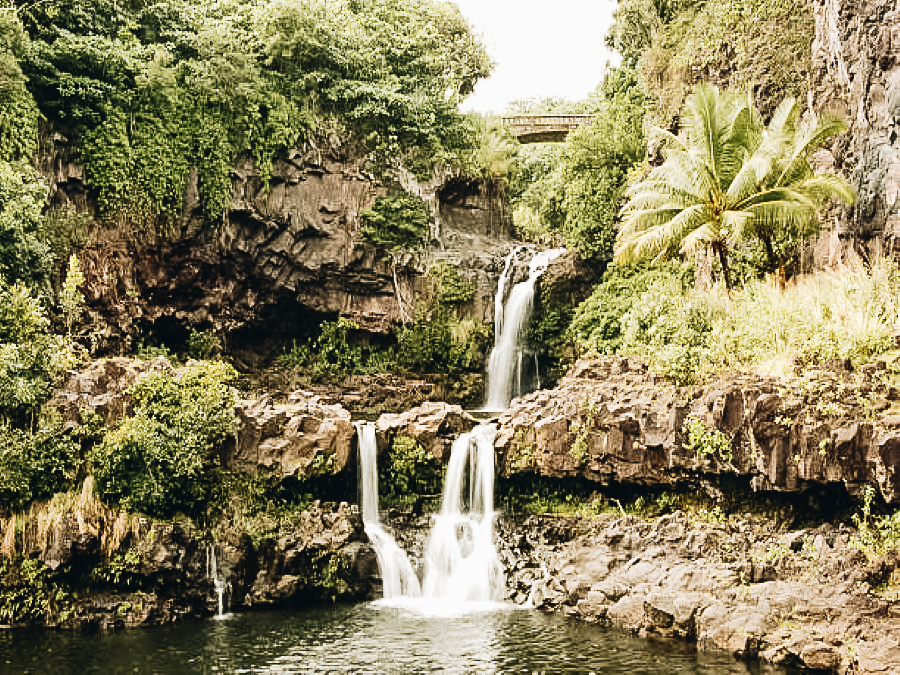When you hear the word ‘blowhole’, your initial though may be of a whale spewing water out of the little round hole on its back. Though that is a type of blowhole, it’s not the only kind of blowhole the world has to offer—geological blowholes can be found along rocky coastlines all over the globe. Just like seeing a whale in the sea, these marine geysers are a magical sight to behold. Hawaii has a handful of them to choose from, but one of the most popular is one in Maui called Nakalele Blowhole. Tourists, like ourselves, and natives visit this natural wonder to see the seawater blast up to 100 feet in the air! Seeing it, from a safe distance, is one of the best things to do in Maui.
A Guide to Nakalele Blowhole in Maui, Hawaii
What is a Blowhole
A blowhole, also known as a marine geyser, is a tube-like hole that expels pressurized water into the air. They usually form along rocky coastlines and fault-lines, often on the windward side of the coast where the waves are stronger. Similar to how littoral caves are formed, sea-based blowholes are the result of marine erosion. The waves crash into the crevices of existing fault lines, lava tubes, and littoral caves. The water carves out tunnels by eroding the rock back towards the land and then it pushes up towards the surface. Eventually, an exit hole called the expelling port forms, allowing the trapped seawater to escape in a noisy, pressurized fountain. Cool, right?
All blowholes have three main features: a catchment entrance, a compression cavern, and an expelling port. The size and angle of these features, how they are arranged, and changing tides and swell are the factors that determine how explosively the air and water spew out of the expelling port. Water gets caught in the entrance and pushed into the cavern. The water can’t escape back the way it came in because of the pressure of the waves. That pressure, combined with strong bursts of wind, causes the trapped water to shoot up and out the port at powerful speeds.
About Nakalele Blowhole
Nakalele Blowhole was created by waves crashing into lava tubes that were left by ancient lava flows. The area is surrounded by jagged, black lava rock that creates a raw and unique aesthetic to the experience. This blowhole in Maui shoots so high that, most of the time, you can see it from the road!
It is recommended to visit Nakalele Blowhole in the early morning or late afternoon to avoid the peak of the crowds. If you visit early enough you may get the chance to see how the morning sunshine forms a rainbow in the misty spray of the geyser. Many people report seeing whales jumping out of the water in the distance during their visit, creating an even more magical experience!
On particularly calm days, where there is little wind and the swells are smaller, the geyser can be inactive. However, some days it blasts every few minutes.

Along with the geyser, there are several other attractions on this side of the island to add to the Nakalele adventure.
- Nakalele Point Lighthouse is a small lighthouse that offers stunning views of the surrounding land, rocks, tide pools, and waves.
- Between the lighthouse and Nakalele Blowhole are some interesting rock formations.
- About ten minutes away, via HI-340, are the Olivine Pools. They are beautiful and well worth the trip, but they also tend to draw a crowd.
- Anyone wanting to swim or relax on the beach can visit D.T. Fleming Beach before or after seeing Nakalele Blowhole. The beach is twenty minutes away from it.
Nakalele Blowhole Safety Warning for Visitors
This natural wonder is one that should be treated with respect, not only for its beauty and wonder, but for the danger as well. Unfortunately, it has taken lives before. Maui has put out warning signs around Nakalele Blowhole telling people not to get too close, for good reason. Even when the blowhole is inactive it can pose a threat.
There are two warning signs posted that you should pay attention to. One is right outside of the parking lot and the other one is located right before you get onto the trail leading down to the blowhole.
“Warning Stay clear of Blowhole you can be sucked in and killed. It is not a waterpark!”
That sign tells the horrifying truth since there have been a few deaths resulting from people getting too close to the hole. Plus, non-fatal accidents happen all the time, with people getting injured from falling on the slippery rocks. It is important to wear proper shoes and to watch where you step. DON’T do what I did and wear flip-flops!
It is never a good idea to stand in between the ocean and the blowhole. Unexpected waves can come in and push people into the hole. Once someone is in there, they are stuck. In 2011, a man was standing on the edge looking into the hole when he was hit by a sudden wave, pushed into the blowhole, and drowned. His body was never recovered.
It looks innocent enough from this far away. DO NOT get close to the blow hole and look inside, you could get sucked it. Don’t believe? Read this article about a Blowhole Victim.
There have also been a couple of rare instances that people were sucked into the hole when standing too close to it. When the waves retreat, a vacuum-like suction happens that can be extremely forceful. That vacuum will pull anyone that is unlucky enough to fall victim to Nakalele Blowhole into the sea if the waves don’t push them under first.
The general guideline is that standing on dry rocks is the safest way to admire the blowhole in Maui. The geyser makes an impactful sight, even from a safe distance.

How to Get to Nakalele Blowhole
Nakalele Blowhole is located in the western half of Maui, on the northernmost point of the island. A scenic, winding road escorts you to Nakalele Point. At the end of the route the road transitions to a narrow, one-lane road. Drive carefully and it shouldn’t be a problem.
There is also another set of directions that say to head north from Kapalua for about eight miles until you find a mile marker that says 38.5. There are multiple trails from there that all lead down to the blowhole, but the one by the mile marker is said to be the safest route.
Nakalele Blowhole is a popular spectacle that fascinates both tourists and locals. Though visitors must use extreme caution, due to the dangers of getting too close, it is sure to give guests an unforgettable experience.
Traveling Soon? Use my Favorite Resources for Booking Your Trip!
Book Your Flight
Skyscanner is my favorite flight search engine, because it checks dozens of airlines so you can easily find the best fare deals. You can also select ‘cheapest month’ to find the lowest fares for your destination (I use this all the time!).
Book Your Accommodations
I use both Booking.com and Expedia for hotels, because each offers a couple different hotel choices and I like to compare the reviews on each one. If you have a group or are looking for more of a home atmosphere, head over to VRBO or AirBNB that has houses, apartments and even just a room for rent in every price range.
Book Your Rental Car
If love the freedom to explore like I do, driving from place to place is the best option! I always book with Discover Cars for the best prices and top brand options.
Book Some Fun Tours!
Viator and Get Your Guide are my go-to search engines for cool bucket list experiences! Each one can have different tours, so check both—why limit yourself, right?
Don’t Forget Travel Insurance
Travel can be unpredictable. Whether it’s a last-minute cancellation, an injury, or (ugh) theft, things happen. That’s why I recommend never leaving the country without travel insurance. Here are my faves: Safety Wing and World Nomads.
Get Packing & Travel Essentials Ready
Check out the Bucket List Journey Amazon Store to find all my favorite travel essentials. Everything from Packing cubes, to travel adapters and toiletry containers to walking shoes.
*Lastly, check travel.state.gov for visa requirements and safety information.
Save this Post to Pinterest

You Might Also Enjoy
Maui Bucket List: 40 Best Things To Do on the Top Hawaiian Island
Maui Luaus: 9 Best Hawaiian Luaus on the Island
Maui Revealed: The Ultimate Guidebook
Walk a Black Sand Beach on the Road to Hana
Facing Pineapple Gluttony in Hali’imaile
Swim with Sea Turtles in Olowalu
35 of Maui’s Best Road to Hana Stops for a Fun Driving Tour
Paia Maui Bucket List: 12 Things to do in the Town








Nevertheless, the natural element is sometimes unpredictable … Thanks for this guide and safety warning, looking at the photo this place looks beautiful and peaceful …
Maui , Hawaii is one of my dream destination I desperately wants to go . And your post is good enough for me to know more about this destination.
Please be careful getting to close to the Blowhole! It is very slippery when wet! I knew a boy who was sucked into this blow hole in the mid 70’s. He was lucky to survive in that he was sucked out into the ocean unconscious. Several people risked their lives to pull him in from the ocean.